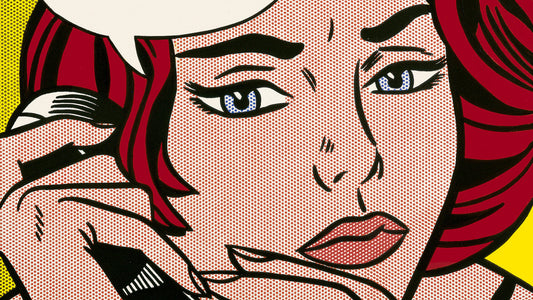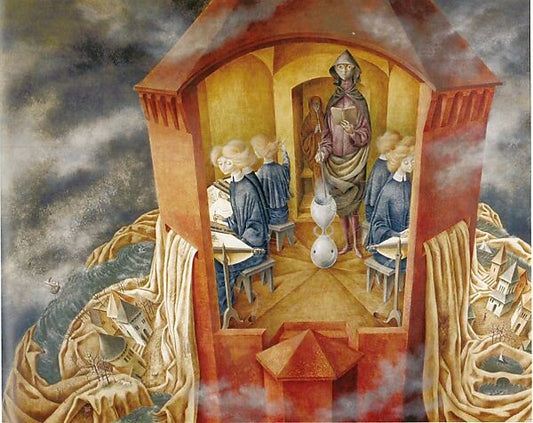Dreams feel like haphazard scenarios—kind of like surrealist art. One moment you’re talking to your dog in your ex-boyfriend’s mom’s house and the next thing you know you’re in a spaceship on your way to Saturn with two people you call your best friends but look like complete strangers. It all feels surreal.
Here’s a list of five surrealist paintings that might feel familiar from last night’s sleep.
Eine Kleine Nachtmusik, “A Little Night Music,” Dorothea Tanning, (1943)

As a kid, everything seems so significant when you are so small. The large doors and giant sunflowers are familiar but random—a common motif in surrealist paintings. But what makes this piece feel like a fever dream is how it borders the line between normal and chilling. The child’s hair sticking straight up, defying gravity, combined with the sunflower’s stem broken like spider legs makes you wonder, “What is going on here?”
Tanning’s inspiration for this painting involved her love for Mozart, hence the title, and her view on confrontation. The painting portrays a child and a doll facing away from one another when there are a number of doors to choose from and stairs to escape. The same aggression that comes with confrontation is seen in the sunflower—known to be one of the more aggressively invasive flowers. However, without dissection, Eine Kleine Nachtmusik feels like a chilling and familial scene from one’s childhood night.
The Old Maids, Leonora Carrington, (1947)

Once again, we see a depiction of a scene that could happen in real life, yet the elements of the painting are tainted, evoking mixed emotions from the viewer. In a room of four women with misshapen proportions, a younger child faces away from them holding a cup of tea. Similar to our dreams, the scene seems rather normal. But upon further investigation, normalcy shifts to discord. Magpies and a monkey join the ladies for tea while an abnormally small fire warms the space in the fireplace.
Carrington’s goal with The Old Maids was to highlight themes of fertility, womanhood, aging, and culinary practices. The alliance between animals and humans in The Old Maids is reminiscent of her novel’s plot, The Hearing Trumpet, where a woman cooks herself into a broth and joins a post-polycyclic community with cats, wolves, and dogs. Totally normal and not evocative of a fever dream, right?
Tomorrow Is Never, Kay Sage (1955)

In an eerie, isolated, and deconstructed city, Sage emulates how nightmares can feel. Unfortunately, Sage’s nightmare became a reality. Tomorrow Is Never was produced after a five-month career hiatus following the abrupt death of her husband. The bones of the skyscrapers tower over the clouds, allowing the viewer to “hear” the high-pitched whistling of the wind piercing through the holes of the scaffolding. The monotone greys not only set the mood for the painting but also mirror Sage’s emotions during this time. Nightmares often capture one’s worst fears: spiders, snakes, the ocean, heights, death, or isolation. Tomorrow Is Never encapsulates the feeling of isolation and solitude—the same emotions felt after the death of a loved one, a common motif in nightmares.
Papilla Estelar, “Star Maker,” Remedios Varo, (1958)
Papilla Estelar is chillingly whimsical with the glowing moon and a woman’s lanky body and sharp features. If there’s one thing we know already, it is that surrealism resembles reality but in a bizarre way. For Varo, using a meat grinder to crush stars and feed them to the moon was her strange component. The woman trapped in a tower is meant to represent the events occurring in Varo’s life.
She was exiled from Spain and fled to Mexico where her artwork was not widely accepted by the locals. She felt trapped, hence the small tower, and longed for hope. The woman pulverizing the stars is meant to symbolize Varo’s efforts to grasp onto any potential hope and feeding the stardust to the moon is her way of transforming yearning into an opportunity to escape the looming fear of being isolated forever.

La Esfinge, “The Sphinx,” David Gore, (1988)
And last, but certainly not least, is David Gore’s La Esfinge. The landscape capitalizes on the recurring stylistic choices of surrealism: overcast sky and neverending floor. The family as the main focal point invites the viewer to recall a dream that took place in a familial setting, yet something remained off—possibly a personified naked version of the iconic Sphinx or the fact you and your family members are wearing gas masks in the middle of nowhere.
Either way, La Esfinge, and fever dreams hold some underlying meaning. Typically, dreams highlight intense emotions one feels throughout the day, such as stress or grief.

Gore’s painting highlights historic events and their associated symbols—a child dragging a Trojan horse toy, the gas masks similar to the ones distributed during World War II and the Cold War, the marble statue that is an iconic emblem of the Roman Age, and the Sphinx that symbolizes one of Ancient Egypt’s greatest builds. It is interesting that Gore put two major representations of war together alongside two structures that illustrate a time of great architectural development. Oh, and the woman’s chest on a lion’s body is also pretty intriguing.
One of the best things about surrealist art is that the viewer can interpret it any way they want, but sometimes art is just art. Dreams can be analyzed similarly—our personalized movies could emphasize how we feel during the day or sometimes we just have weird, bizarre, unexplainable fever dreams.
©ArtRKL™️ LLC 2021-2023. All rights reserved. This material may not be published, broadcast, rewritten or redistributed. ArtRKL™️ and its underscore design indicate trademarks of ArtRKL™️ LLC and its subsidiaries.





